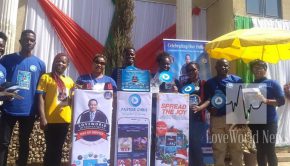Malaria as a Deadly Disease
By Nwosu Onyekachi Immaculatar
Malaria is a life-threatening mosquito-borne blood disease.
The Anopheles mosquito transmits it to humans.
The parasites in mosquitos that spread malaria belong to
the Plasmodium genus. Over 100 Trusted Source types of Plasmodium parasite
can infect a variety of species. Different types replicate at different rates,
changing how quickly the symptoms escalate, and the severity of the disease.
Five types Trusted Sources of Plasmodium parasite
can infect humans. These occur in different parts of the world. Some cause a
more severe type of malaria than others.
Once an infected mosquito bites a human, the parasites multiply
in the host's liver before infecting and destroying red blood cells.
In some places, early diagnosis can help treat and control
malaria. However, some countries lack the resources to carry out effective
screening.
Currently, no vaccine is available for use in the United States,
although one vaccine has a license in Europe.
In the early 1950s, advances in treatment eliminated malaria
from the U.S. However, between 1,500 and 2,000 Trusted Sources cases still occur each year, mostly in
those who have recently traveled to malaria-endemic areas.
Symptoms
Doctors
divide malaria symptoms into two categories Trusted Source: Uncomplicated and severe malaria.
Uncomplicated
malaria

Malaria is passed on by the Anopheles
mosquito.
A
doctor would give this diagnosis when symptoms are present, but no symptoms
occur that suggest severe infection or dysfunction of the vital organs. This
form can become severe malaria without treatment, or if the host has poor or no
immunity.
Symptoms
of uncomplicated malaria typically last 6 to 10 hours and recur every second
day.
Some
strains of the parasite can have a longer cycle or cause mixed symptoms. As
symptoms resemble those of flu, they may remain
undiagnosed or misdiagnosed in areas where malaria is less common.
In
uncomplicated malaria, symptoms progress as follows, through cold, hot, and
sweating stages:
- a
sensation of cold with shivering
- Fever, headache,
and vomiting
- seizures
sometimes occur in younger people with the disease
- sweats,
followed by a return to normal temperature, with tiredness
In areas where malaria
is common, many people recognize the symptoms as malaria and treat themselves
without visiting a doctor.
Severe malaria
In severe malaria,
clinical or laboratory evidence shows signs of vital organ dysfunction.
Symptoms of severe
malaria include:
- fever
and chills
- impaired
consciousness
- prostration,
or adopting a prone position
- multiple
convulsions
- deep
breathing and respiratory distress
- abnormal
bleeding and signs of anemia
- clinical jaundice and
evidence of vital organ dysfunction
Severe malaria can be
fatal without treatment.
Doctors divide malaria
symptoms into two categories Trusted Sources: Uncomplicated and severe malaria.
Uncomplicated malaria
A doctor would give
this diagnosis when symptoms are present, but no symptoms occur that suggest
severe infection or dysfunction of the vital organs.
This form can become
severe malaria without treatment, or if the host has poor or no immunity.
Symptoms of
uncomplicated malaria typically last 6 to 10 hours and recur every second day.
Some strains of the
parasite can have a longer cycle or cause mixed symptoms.
As symptoms resemble
those of flu, they may remain
undiagnosed or misdiagnosed in areas where malaria is less common.
In uncomplicated
malaria, symptoms progress as follows, through cold, hot, and sweating stages:
- a
sensation of cold with shivering
- fever, headaches,
and vomiting
- seizures
sometimes occur in younger people with the disease
- sweats,
followed by a return to normal temperature, with tiredness
In areas where malaria
is common, many people recognize the symptoms as malaria and treat themselves
without visiting a doctor.
Severe malaria
In severe malaria, clinical or
laboratory evidence shows signs of vital organ dysfunction.
Symptoms of severe malaria include:
- fever
and chills
- impaired
consciousness
- prostration,
or adopting a prone position
- multiple
convulsions
- deep
breathing and respiratory distress
- abnormal
bleeding and signs of anemia
- clinical jaundice and
evidence of vital organ dysfunction
Severe malaria can be fatal without
treatment.
Treatment aims to eliminate the
Plasmodium parasite from the bloodstream.
Those without symptoms may be
treated for infection to reduce the risk of disease transmission in the
surrounding population.
The World Health Organization (WHO)
recommends artemisinin-based combination therapy (ACT) to treat uncomplicated
malaria.
Artemisinin is derived from the
plant Artemisia annua, better known as sweet wormwood. It rapidly
reduces the concentration of Plasmodium parasites in the
bloodstream.
Practitioners often combine ACT with
a partner drug. ACT aims to reduce the number of parasites within the first 3
days of infection, while the partner drugs eliminate the rest.
Expanding access to ACT treatment
worldwide has helped reduce the impact of malaria, but the disease is becoming
increasingly resistant to the effects of ACT.
In places where malaria is resistant
to ACT, treatment must contain an effective partner drug.
The WHO has warned that no
alternatives to artemisinin are likely to become available for several years.
Prevention
There are several ways to keep
malaria at bay.
Vaccination
Research to develop safe and
effective global vaccines for malaria is ongoing, with the licensing of one vaccine already having occurred in Europe. No vaccine is yet
licensed in the U.S.
Seek medical attention for suspected
symptoms of malaria as early as possible.
Advice for travelers
While malaria is not endemic to the
U.S., travel to many countries around the world entails a risk.
- find
out what the risk of malaria is in the country and city or region they are
visiting
- ask
their doctor what medications they should use to prevent infection in that
region
- obtain
antimalarial drugs before leaving home, to avoid the risk of buying
counterfeit drugs while abroad
- consider
the risk for individual travelers, including children, older people,
pregnant women, and the existing medical conditions of any travelers
Travelers
to places where malaria is prevalent should take precautions, for example,
using mosquito nets.
- ensure
they will have access to preventative tools, many of which are available
to purchase online, including insect repellants, insecticides, pre-treated bed nets,
and appropriate clothing
- be
aware of the symptoms of malaria
In emergency situations, local
health authorities in some countries may carry outTrusted
Source "fogging," or
spraying areas with pesticides similar to those used in household sprays.
The WHO points out that these
are not harmful for people, as the concentration of pesticide is only
strong enough to kills mosquitoes.
While away, travelers should, where
possible, avoid situations that increase the risk of being bitten by
mosquitoes. Precautions include taking an air-conditioned room, not camping by
stagnant water, and wearing clothes that cover the body at times when
mosquitoes are most likely to be around.
For a year after returning home, the
traveler may be susceptible to symptoms of malaria. Donating blood may also not
be possible for some time.
Causes
Malaria happens when a bite from the
female Anopheles mosquito infects the body with Plasmodium.
Only the Anopheles mosquito can transmit malaria.
The successful development of the
parasite within the mosquito depends on several factors, the most important
being humidity and ambient temperatures.
When an infected mosquito bites a
human host, the parasite enters the bloodstream and lays dormant within the
liver.
The host will have no symptoms for
an average of 10.5 days, but the malaria parasite will begin multiplying during
this time.
The liver then releases these new
malaria parasites back into the bloodstream, where they infect red blood cells
and multiply further. Some malaria parasites remain in the liver and do not
circulate til later, resulting in recurrence.
An unaffected mosquito acquires
parasites once it feeds on a human with malaria. This restarts the cycle.
Early diagnosis is critical for
recovery from malaria.
Anyone showing signs of malaria
should seek testing and treatment immediately.
The WHO strongly advise confirmation
of the parasite through microscopic laboratory testing or by a rapid diagnostic
test (RDT), depending on the facilities available.
No combination of symptoms can
reliably distinguish malaria from other causes, so a parasitological test is
vital for identifying and managing the disease.
In some malaria-endemic areas, such
as sub-Saharan Africa, the disease's severity can cause mild immunity in a
large proportion of the local population.
As a result, some people carry the parasites
in their bloodstream but do not fall ill.
https://www.medicalnewstoday.com/articles/150670.php#causes







